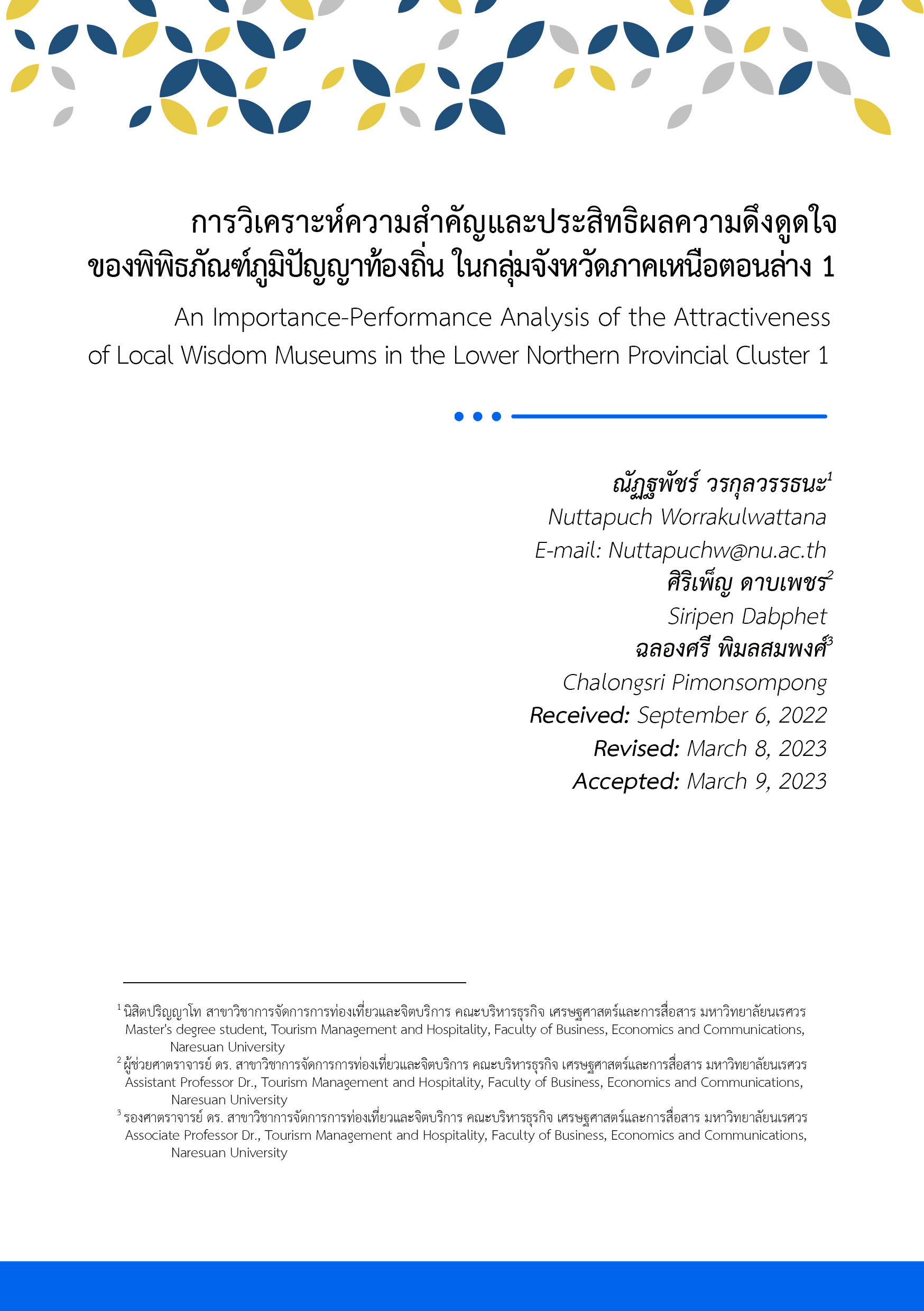An Importance-Performance Analysis of the Attractiveness of Local Wisdom Museums in the Lower Northern Provincial Cluster 1 การวิเคราะห์ความสำคัญและประสิทธิผลความดึงดูดใจของพิพิธภัณฑ์ภูมิปัญญาท้องถิ่น ในกลุ่มจังหวัดภาคเหนือตอนล่าง 1
Main Article Content
Abstract
This research aims to study the attractiveness of local wisdom museum components from the tourists’ perspectives and to provide a guideline to create the attractiveness of local wisdom museums in the lower northern Provincial Cluster 1. A quantitative research design was used. A survey questionnaire of 400 Thai tourists who visited the local wisdom museums in the area were collected. Statistical analysis was employed as a technique to avail demographic characteristics of the tourists. Importance-performance analysis was used to examine the attractiveness of local wisdom museum components. In addition, SWOT analysis was used to strategically identify areas of improvement for the attractiveness of local wisdom museums. The results showed that the attractiveness of local wisdom museums can be divided into 2 levels: the highest level of attractiveness which are objects in the museums and exhibitions, and the high level of attractiveness which are the location of the museums, reception/ticket office, souvenir areas and general facilities. The IPA analysis indicated the main factors that need to be improved in local wisdom museums are display and exhibition to encourage tourists to get involved with the museums. Additionally, exhibitions in the local wisdom museums need to stimulate discussions with family and friends.
Downloads
Article Details

This work is licensed under a Creative Commons Attribution-NonCommercial-NoDerivatives 4.0 International License.
References
Boley, B. B., McGehee, N. G., & Hammett, A. T. (2017). Importance-performance analysis (IPA) of sustainable tourism initiatives: The resident perspective. Tourism management, 58, 66-77.
Caber, M., Albayrak, T., & Matzler, K. (2012). Classification of the destination attributes in the content of competitiveness (by revised importance- performance analysis). Journal of Vacation Marketing, 18(1), 43-56.
Calderwood, L. U., & Soshkin, M. (2019). The travel and tourism competitiveness report 2019. Geneva, Switzerland: World Academic Forum.
Cochran, R. N., & Horne, F. H. (1977). Statistically weighted principal component analysis of rapid scanning wavelength kinetics experiments. Analytical Chemistry, 49(6), 846-853.
Gaweewong, G. (2015). The curator of small parts of history: The Jim Thompson Art Center. In Museum Refocused (pp. 85-100). Bangkok: Museum Siam, Discovery Museum.
Kim, S. S., Guo, Y., & Agrusa, J. (2005). Preference and positioning analyses of overseas destinations by mainland Chinese outbound pleasure tourists. Journal of travel research, 44(2), 212-220.
Kresic, D. (2008). Index of destination attractiveness (IDA): A tool for measuring attractiveness of tourism destination. Paper presented at the An Enterprise Odyssey. International Conference Proceedings.
Krešić, D., & Prebežac, D. (2011). Index of destination attractiveness as a tool for destination attractiveness assessment. Tourism: An International Interdisciplinary Journal, 59(4), 497-517.
Limapornvanitr, T. (2022). Technology that supports learning in the museum. Journal of Industrial Education, 21(2), C1-C15.
Ma, E., Hsiao, A., & Gao, J. (2018). Destination attractiveness and travel intention: the case of Chinese and Indian students in Queensland, Australia. Asia Pacific Journal of Tourism Research, 23(2), 200-215.
Markowski, J., Bartos, M., Rzenca, A., & Namiecinski, P. (2019). An evaluation of destination attractiveness for nature-based tourism: Recommendations for the management of national parks in Vietnam. Nature Conservation, 32, 51-80.
Martilla, J. A., & James, J. C. (1977). Importance-performance analysis. Journal of marketing, 41(1), 77-79.
Moutinho, L. (1987). Consumer behaviour in tourism. European journal of marketing, 21(10), 5-44.
Natprasert, P., Boriboon, K., & Sangsri, S. (2017). Management of local museums to promote lifelong learning. Veridian E-Journal Silpakorn University, 7(3), 861-878.
Nowacki, M. M. (2005). Evaluating a museum as a tourist product using the servqual method. Museum Management and Curatorship, 20(3), 235-250.
Oh, H. (2001). Revisiting importance–performance analysis. Tourism management, 22(6), 617-627.
Panyachit, S. (2019). Local museums : Roles in arts and culture and development towards sustainability . Fine Arts Journal: Srinakharinwirot University, 23(2), 113-128.
Phadermrod, B., Crowder, R. M., & Wills, G. B. (2019). Importance-performance analysis based SWOT analysis. International journal of information management, 44, 194-203.
Princess Maha Chakri Sirindhorn Anthropology Centre (Public Organisation). (2020). 1,579 Museums in Thailand: A museum database that collects and presents museum information from all over the country. Bangkok: Author.
Seddighi, H. R., & Theocharous, A. L. (2002). A model of tourism destination choice: a theoretical and empirical analysis. Tourism management, 23(5), 475-487.
Sirasoonthorn, P., Satean, G., Khamunee, W., & Pirasan, J. (2016). A development of the logistic creative community economy for the promotion of participatory cultural tourism: A case of cultural World Heritage, Thailand. Journal of Community Development Research (Humanities and Social Sciences), 9(3), 10-20.
Smith, S. L. (1987). Regional analysis of tourism resources. Annals of tourism research, 14(2), 254-273.
Sukbanjong, S. (2019). The development model for museums and contemporary arts gallery management in the context of the creative city and the ASEAN socio-cultural community-ASCC. Journal of Thai Studies, 15(1), 167-204.
Supun, J. (2022). Guidelines for using local stories to convey meaning in promoting creative tourism Chainat Province Singburi Province and Lopburi Province. Journal of Mekong-Salween Civilization Studies, 13(2), 250-279.
Tang, J. C., & Rochananond, N. (1990). Attractiveness as a tourist destination: a comparative study of Thailand and selected countries. Socio-Economic Planning Sciences, 24(3), 229-236.
Thansettakij. (2017). Development of QR-AR Code System for Using as National Museum Guide. Retrieved from http://www.thansettakij.com /content /167710
Tussama, K. (2013). The assessment of the impacts of tourism on the economy, environment, society and culture: Case study of Dokkhamtai District, Phayao Province, Thailand. Journal of Management Information and Decision Sciences, 24(1s), 1-9.
Vengesayi, S. (2003).Destination attractiveness and destination competitiveness: A model of destination evaluation. Paper presented at the ANZMAC 2003 Conference Proceedings Adelaide.


